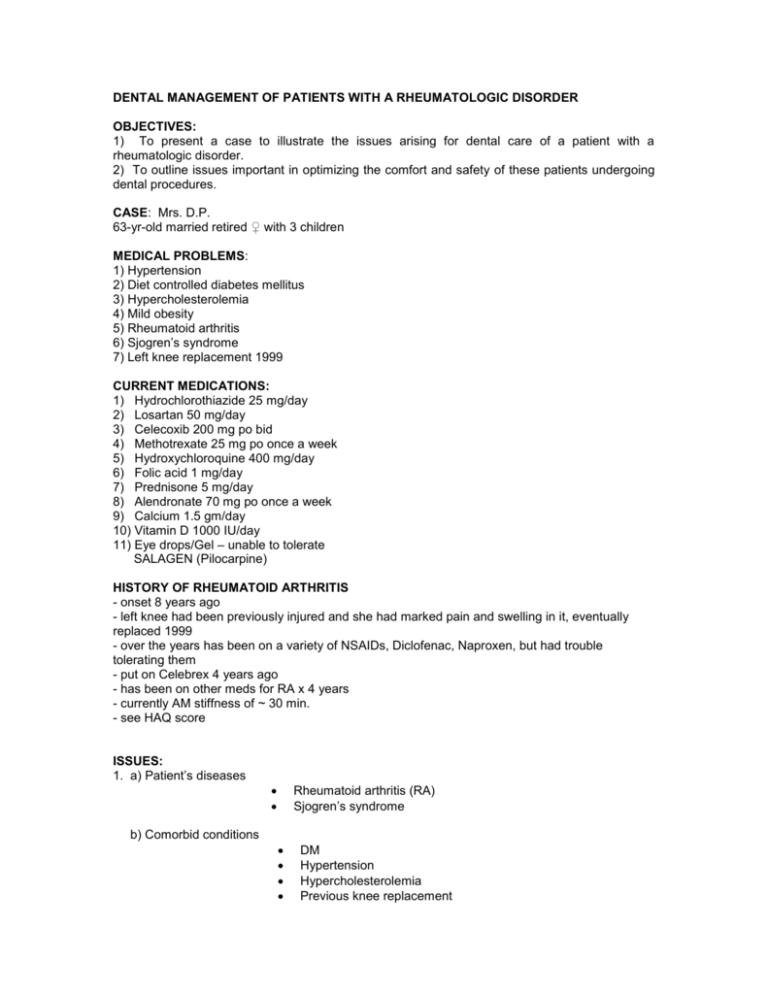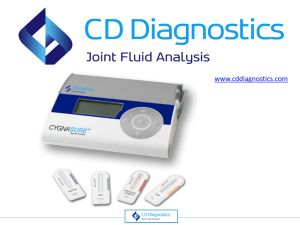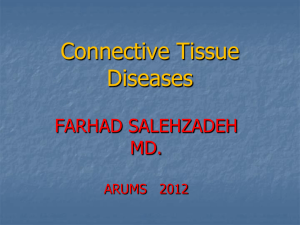15. Rheumatology
advertisement

DENTAL MANAGEMENT OF PATIENTS WITH A RHEUMATOLOGIC DISORDER OBJECTIVES: 1) To present a case to illustrate the issues arising for dental care of a patient with a rheumatologic disorder. 2) To outline issues important in optimizing the comfort and safety of these patients undergoing dental procedures. CASE: Mrs. D.P. 63-yr-old married retired ♀ with 3 children MEDICAL PROBLEMS: 1) Hypertension 2) Diet controlled diabetes mellitus 3) Hypercholesterolemia 4) Mild obesity 5) Rheumatoid arthritis 6) Sjogren’s syndrome 7) Left knee replacement 1999 CURRENT MEDICATIONS: 1) Hydrochlorothiazide 25 mg/day 2) Losartan 50 mg/day 3) Celecoxib 200 mg po bid 4) Methotrexate 25 mg po once a week 5) Hydroxychloroquine 400 mg/day 6) Folic acid 1 mg/day 7) Prednisone 5 mg/day 8) Alendronate 70 mg po once a week 9) Calcium 1.5 gm/day 10) Vitamin D 1000 IU/day 11) Eye drops/Gel – unable to tolerate SALAGEN (Pilocarpine) HISTORY OF RHEUMATOID ARTHRITIS - onset 8 years ago - left knee had been previously injured and she had marked pain and swelling in it, eventually replaced 1999 - over the years has been on a variety of NSAIDs, Diclofenac, Naproxen, but had trouble tolerating them - put on Celebrex 4 years ago - has been on other meds for RA x 4 years - currently AM stiffness of ~ 30 min. - see HAQ score ISSUES: 1. a) Patient’s diseases Rheumatoid arthritis (RA) Sjogren’s syndrome b) Comorbid conditions DM Hypertension Hypercholesterolemia Previous knee replacement 2. Potential “Adverse Effects” of RA/Sjogren’s with respect to: Risk of infection → YES Risk of bleeding → only if associated ↓’d platelets Ongoing disability/quality of life 3. Potential “Adverse Effects” of Drugs on: Risk of infection ? bleeding ? stress of procedure Quality of life RHEUMATOID ARTHRITIS - RA associated with pain, stiffness, deformity, and cumulative disability - probable ↑ risk of infection from disease, risk of bacterial seeding to damaged joints or replaced ones - difficult for patients to use floss/toothbrush, open mouths adequately (TMJ) - if severe neck involvement: pain, ↓ mobility, ?subluxation and hyperextension - difficulty getting in and out of chair - cost of dental care and coverage SJOGREN’S - often associated with RA - dry parched mouth/burning throat - trouble chewing/swallowing, gritty eyes - ↑ tooth decay →need for more frequent appointments - need for alternative cleaning products, BIOTENE - ↑ risk of moniliasis and other intraoral lesions Patient comfort given RA/Sjogren’s: i.e. need for short appointments, preferably in PM need to move frequently (gelling TMJ) dry mouth and keeping it open for extended periods ? help with preventive dental care (floss holders, toothbrush, Occupational Therapist) DRUGS: Celecoxib - COX 2 inhibitor - won’t affect bleeding, no ↑ infection risk - older NSAIDs – some bleeding risk Methotrexate - need to check that platelets/WBC are normal - ? ↑ risk of infection - ? ↑ risk of moniliasis Hydroxychloroquine/Folic acid/Fosamax/ Vit D/Calcium - no specific problems Prednisone - ↑ risk of infection - adrenal insufficiency → ↑ dose if more stressful procedure COMORBID CONDITIONS: Hypertension – HCTZ may make mouth even dryer Diabetes Mellitus - ↑ risk of infection if blood sugar is not well controlled ? should such a person receive antibiotic prophylaxis – probably a good idea OTHER CONSIDERATIONS IN TREATING RHEUMATOID ARTHRITIS PATIENTS: Use of other drugs which might impair immunity: 1) Biologics – e.g. Etanercept/ Infliximab/Anakinra 2) Leflunomide - ? effect on platelets, white count - ?↓ resistance to infection 3) Less commonly used: Azathioprine/gold SUMMARY: → Rheumatoid arthritis is a serious systemic disease which is painful and fatiguing and can lead to significant disability. → Disability can make it difficult for patients to look after their teeth and gums → Drugs the person is on can affect risk of infection, risk of bleeding. → Dental care needs to be planned according to the individual needs of the patient, their degree of disability, their comorbid conditions, age, and the drugs they are taking. → Reasonable to call the person’s physician or specialist if any concerns.











